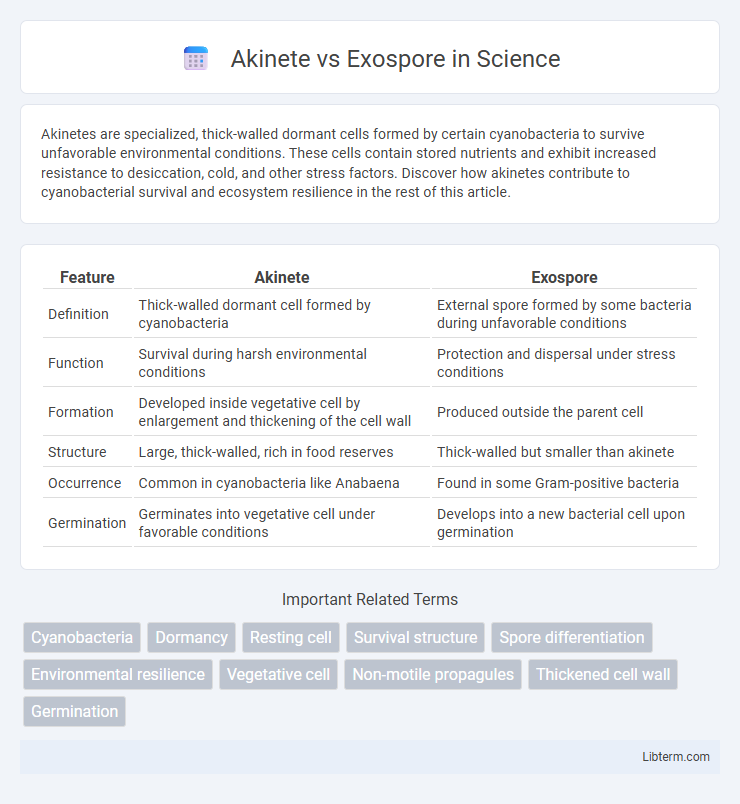Akinetes are specialized, thick-walled dormant cells formed by certain cyanobacteria to survive unfavorable environmental conditions. These cells contain stored nutrients and exhibit increased resistance to desiccation, cold, and other stress factors. Discover how akinetes contribute to cyanobacterial survival and ecosystem resilience in the rest of this article.
Table of Comparison
| Feature | Akinete | Exospore |
|---|---|---|
| Definition | Thick-walled dormant cell formed by cyanobacteria | External spore formed by some bacteria during unfavorable conditions |
| Function | Survival during harsh environmental conditions | Protection and dispersal under stress conditions |
| Formation | Developed inside vegetative cell by enlargement and thickening of the cell wall | Produced outside the parent cell |
| Structure | Large, thick-walled, rich in food reserves | Thick-walled but smaller than akinete |
| Occurrence | Common in cyanobacteria like Anabaena | Found in some Gram-positive bacteria |
| Germination | Germinates into vegetative cell under favorable conditions | Develops into a new bacterial cell upon germination |
Introduction to Akinetes and Exospores
Akinetes are thick-walled, dormant cells formed by certain filamentous cyanobacteria to survive adverse environmental conditions, characterized by their large size and nutrient-rich granules. Exospores are specialized reproductive structures produced by some bacteria, notably Actinomycetes, designed for dispersal and survival, featuring a distinct spore coat but lacking the thickened walls of akinetes. Both structures serve as survival mechanisms, with akinetes primarily providing resistance to environmental stresses and exospores facilitating reproduction and distribution.
Definition and Basic Characteristics
Akinetes are thick-walled, dormant cells formed by certain cyanobacteria to survive unfavorable environmental conditions, characterized by their large size and ability to store nutrients. Exospores are a type of asexual spore produced externally by some bacteria, featuring a resilient outer layer that enables survival but lacking the nutrient reserves seen in akinetes. Both serve as survival structures, with akinetes functioning primarily in long-term dormancy and exospores facilitating rapid dispersal and resistance.
Formation Processes
Akinetes form through the thickening of cell walls and accumulation of food reserves within certain cyanobacteria, enabling survival under unfavorable environmental conditions. Exospores originate from the budding of specialized cells in some Gram-positive bacteria, involving the outward growth of the cell membrane and wall without complete detachment. The formation of akinetes is primarily a response to nutrient depletion and low light, while exospore formation typically occurs during the bacterial life cycle for reproduction or dispersal.
Structural Differences
Akinetes are thick-walled, large dormant cells formed by cyanobacteria to survive adverse conditions, characterized by their dense cytoplasm and prominent storage granules, whereas exospores are smaller, less robust reproductive cells with thinner walls that facilitate dispersal. Akinetes possess multiple layers in their cell walls, including lipopolysaccharide and glycolipid layers, providing enhanced protection against desiccation and extreme temperatures, unlike exospores, which have fewer protective layers. The structural differentiation reflects their functional roles: akinetes ensure long-term survival, while exospores enable rapid colonization and propagation.
Environmental Triggers for Development
Akinetes develop in response to unfavorable environmental conditions such as cold temperatures, nutrient depletion, and desiccation, enabling cyanobacteria to survive prolonged stress. Exospores form primarily under nutrient limitation and changes in light intensity, providing a protective adaptation for bacterial persistence. Both structures serve as specialized dormant cells triggered by distinct environmental cues to ensure survival and genetic continuity.
Survival and Dormancy Mechanisms
Akinetes are thick-walled, nutrient-rich resting cells formed by certain cyanobacteria to survive unfavorable environmental conditions such as cold or nutrient depletion, enabling long-term dormancy through their dense cytoplasm and durable outer layers. Exospores, produced by some bacterial species, serve as a survival strategy by forming resilient but less complex dormant structures that allow rapid return to vegetative growth once conditions improve. Both akinetes and exospores enhance microbial survival by minimizing metabolic activity and protecting cellular components, but akinetes typically provide extended viability and greater resistance to harsh conditions compared to exospores.
Biological Functions and Roles
Akinetes function as specialized dormant cells in cyanobacteria, enabling survival during unfavorable environmental conditions such as cold or nutrient depletion by storing nutrients and thickening cell walls. Exospores serve as reproductive structures in certain bacteria, facilitating dispersal and colonization without extensive metabolic changes, typically through budding from the parent cell. Both structures play crucial roles in bacterial survival and propagation but differ in formation mechanisms and adaptive strategies.
Ecological Significance
Akinetes serve as survival structures that help cyanobacteria endure unfavorable environmental conditions such as desiccation and cold, enabling population persistence and ecosystem stability. Exospores facilitate rapid dispersal and colonization in nutrient-rich environments, contributing to microbial diversity and nutrient cycling. Both structures play critical roles in maintaining aquatic ecosystem resilience by ensuring microbial continuity and adaptation.
Examples and Occurrence in Microorganisms
Akinetes are thick-walled dormant cells formed by cyanobacteria such as Anabaena and Nostoc, enabling survival in harsh environmental conditions like cold or drought. Exospores are a type of asexual spore produced by certain Gram-positive bacteria, including species of Actinomyces and Brevibacterium, facilitating reproduction without forming true endospores. Both akinetes and exospores are adaptations for survival, but akinetes primarily occur in filamentous cyanobacteria, while exospores are found in soil-associated bacteria.
Key Differences and Summary Table
Akinetes are thick-walled dormant cells formed by cyanobacteria for survival under harsh conditions, characterized by their large size and nutrient storage capability. Exospores, produced by certain bacteria like Bacillus, are non-motile, thin-walled spores that enable rapid germination without substantial nutrient reserves. The key differences include structural features, formation triggers, and germination processes, with akinetes providing long-term resistance and exospores facilitating faster reproduction cycles. | Feature | Akinete | Exospore | |-------------------|------------------------------|-------------------------------| | Organism Type | Cyanobacteria | Bacteria (e.g., Bacillus) | | Wall Thickness | Thick | Thin | | Function | Long-term survival | Rapid germination | | Nutrient Storage | Yes | No | | Motility | Non-motile | Non-motile | | Formation Trigger | Nutrient depletion, harsh conditions | Nutrient availability recovery |
Akinete Infographic

 libterm.com
libterm.com